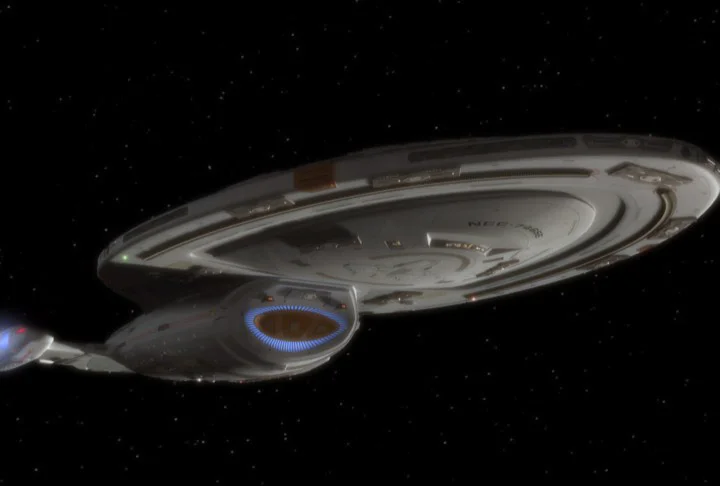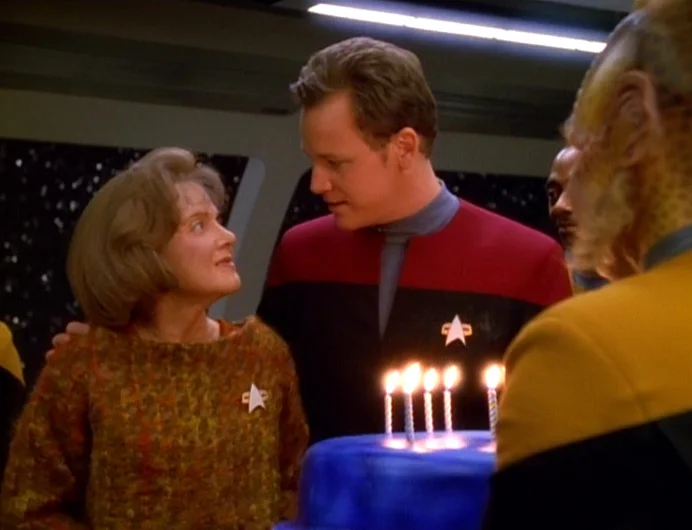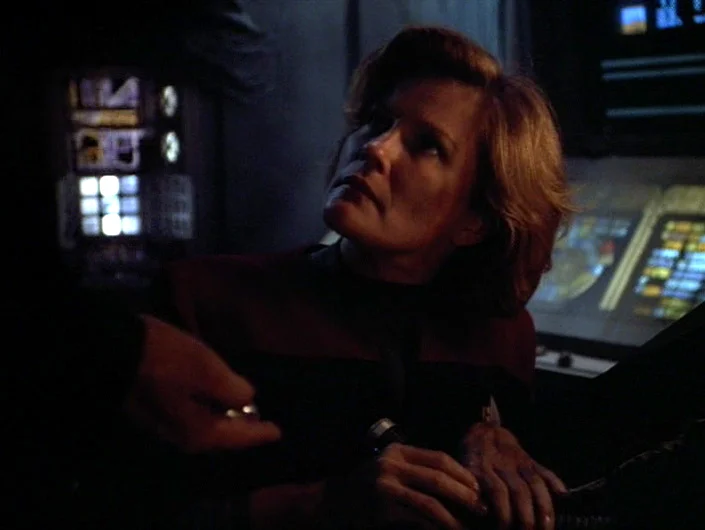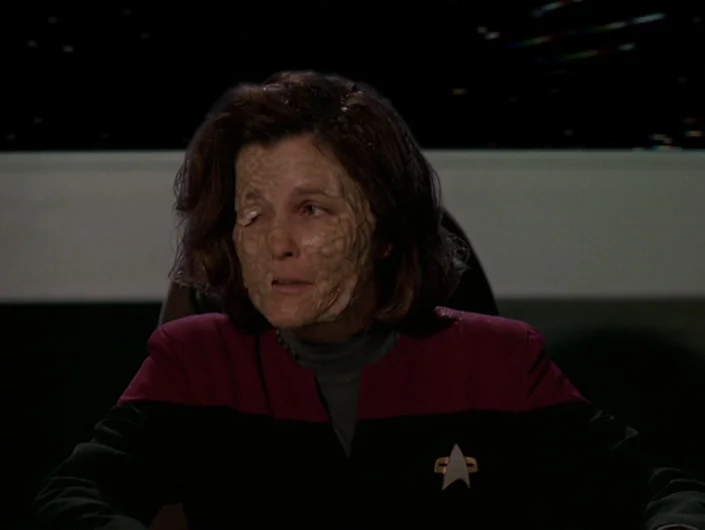by Shervin Sabeghi
The “Reset Button”: it’s a phrase so thrown around when talking about Voyager that no fan can escape the Trek world without it finding its way into their ears at least once. And, unlike a lot of the criticism fans give Voyager that might be subject to opinion, comments about the reset button do actually apply. In short, if anything of epic proportion happens that results in the destruction of a permanent component of the show, or if an episode has dabbled in time travel and has screwed up the timeline good and proper, the writers press the reset button and, bippity boppity boo, everything’s back to how it was at the beginning of the episode. With all of the Trek series touching upon time travel in some way, the reset button has been featured on all the series; however, since Voyager was on its own in the Delta Quadrant, the writers weren’t at liberty to blow up Federation ships left, right and centre, so when they wanted to actually do anything so dramatic, it nearly always required a large dose of reset. This happened so many times on Voyager that it was dubbed the “HMS Reset Button” and was even once featured as the picture of the Reset Button section of tvtropes.org. Let’s take a closer look at the many uses of the reset button on Voyager.
The Weekly Reset
When it comes to Voyager, many extend the definition of the reset button to include how they felt that each episode seemed to have little effect on the episodes after it. Some didn’t appreciate how the characters seemingly forgot their previous experiences, i.e., as in how things from previous episodes were hardly ever mentioned in later episodes. This is why, when there were throwbacks to earlier episodes, the fans highly appreciated it. For example, when B’Elanna mentions in season two’s “Lifesigns” what occurred in season one’s “Faces,” it was a rare instance that showed that sometimes the characters do indeed remember the life-changing things that have happened in previous adventures.
Furthermore, after “Caretaker” and certain episodes in season one where we see how Voyager’s distance from the Federation will be a strain on the ship’s supplies, many were looking forward to seeing this played out as an ongoing struggle. It was seen in some episodes such as “Demon,” where Voyager enters ‘grey mode’ to conserve energy. However, for the most part, it was a dropped storyline. After each episode, it was as if the reset button magically restocked Voyager’s supplies. This relatively small ship, which was sent out for a mission that was meant to last no more than a few weeks, gives the impression that it has no real trouble sustaining its crew every week. Whether this happened through the endless supply of photon torpedoes that originally began with an irreplaceable set of 38, or how Chakotay singlehandedly destroyed a full fleet of shuttles, the apparent resetting of Voyager’s supplies really irked fans who were looking forward to seeing a crew constantly scrounging around for things to power their ship.
Similar to the problem with Voyager’s supplies, another thing the premise of the show promised that wasn’t realised due the reset button was wear and tear to Voyager itself. Being thousands of light years away from a Starfleet dry-dock repair station, one would think that Voyager would suffer a steady deterioration from all of the attacks it received, so much so that after its seven year journey, it would have noticeable damage. But, alas, at the beginning of every single episode — even after instances where it received heavy damage such as in “Deadlock” and “Equinox” — we’d see Voyager looking as sparkly and undamaged as it was when we first saw it docked at Deep Space Nine in “Caretaker.” The reset button strikes again.
Though some could argue that use of the reset button was a more subtle but constant part of Voyager, it still has its episodes with a clear, traditional use of the reset button – here are some of the main examples.
Time and Again
Perhaps not a glowing example of Voyager at its best, the fact remains that the earliest use of the reset button in Voyager was in the fourth episode of the first series with “Time and Again.” Voyager encounters a planet which has been ravaged by a disaster of sorts and, when they go to investigate, Janeway and Paris are taken back in time to just before the disaster. A trail of forgettable events leads to them realising that they were the cause of the disaster, and they must stop themselves. What counts as memorable parts of this story are such for the wrong reasons, like the ridiculous outfits akin to an extremely bad circus color palate, as well as Kes’ Troi/Sarah Connor-esque premonition about the planet being destroyed. The end of this episode features one of the most insulting uses of the reset button; Janeway prevents herself from causing the disaster and, by doing so, resets the entire episode to the beginning, meaning that all of what we endured was for nothing. The very few good elements of this story, such as the character development that we saw, never even happened.
Before and After
In this late season three episode, an elderly Kes from Voyager’s future involuntarily jumps backward in time. However, with the help of the Doctor from various timelines, Kes returns herself to the present timeline and stops the time jumping for good. Though the reset button does apply in this episode (as the possible future for Voyager doesn’t happen in the end), it’s a variation of the reset button from the usual. This time, instead of the events of an episode being completely reset with no recollection of what happened by any of the characters, what happens in the episode is used as foreshadowing for the future episode “Year of Hell,” as Kes remembers the events of the future and warns the crew about what happens. Because of this, “Before and After” has, arguably, Voyager’s best use of the reset button, as it allows the writers to hint at something big that may happen in the future so they can build anticipation for it. Unfortunately, it must be said that when “Year of Hell” was played out in the next season, the crew didn’t seem to use the information that Kes had given them about what will happen — a fact which takes away from “Before and After.”
Year of Hell
“Year of Hell” features Voyager’s biggest use of the reset button. In this two-part episode, we are introduced to the Krenim, an alien species that has most of what they have because of their superior temporal technology. It allows them to completely wipe out entire planets from time, thus decimating their existence — and that of any inhabitants. Of all the Voyager episodes, the word epic applies the most to this one. In the first part, Voyager is constantly attacked by Krenim ships, which are trying to destroy them because they’ve apparently violated their space. By the end of part one, Voyager has been severely damaged and, with half of the ship uninhabitable, Janeway must order every surviving crew member to abandon ship except for the senior staff — including Neelix, for whatever reason. Despite the amazing storytelling in part one, devoted fans know that somehow, the reset button will present itself in part two. The ship has been too badly damaged, the crew compliment has been too critically reduced, Tuvok has been blinded and, most importantly, Janeway’s hair has been to hell and back. And, to no one’s surprise, the end of part two sees Janeway flying her ship into Annorax’s vessel, which causes a temporal incursion inside Annorax’s ship. This removes his ship from existance and resets everything to when Voyager first encounters a Krenim ship at the beginning of part one. This time however, the Krenim ship doesn’t attack and Voyager continues on their journey.
This episode, particularly part one, is a fan favourite. It’s an action epic as well as a story with great character moments. The reset button ending does somewhat let it down as it makes some think, “Well, what was the point of all the action and drama if none of it happened anyway?” but most can forgive the ending due to the fantastic moments before it. Some, however, also see it as another missed opportunity for Voyager, and they wish that the episode had occupied the whole of one season and that the effects of something so damaging had actually been experienced by the characters. Even so, “Year of Hell” shows a much better use of the reset button than “Time and Again,” as it actually made sense to the episode’s plot. What was seen leading up to the reset button was more than worth watching.
Course: Oblivion
“Course: Oblivion” from Voyager’s fifth season is unusual: we see the crew members all gradually die. The premise alone requires the reset button. However, in this episode, it is reasonably disputable whether or not the reset button is actually used; we see all of this happen to duplicates of the crew, which were created in the episode “Demon” from the previous season. So, though we see the characters all suffer and die, it begs the question, “Is this really happening to Voyager’s crew, or a bunch of people we have never seen before?” Without looking into things too deeply, another use of the reset button occurs and, just like “Year of Hell,” the reset happens with the destruction of the ship. But, unlike “Year of Hell,” it doesn’t happen by resetting time to when all was still rosy, but instead by revealing that the killed crew was duplicates.
Always Resetting?
Despite the fact that Voyager episodes with heavy emphasis on the reset button were typically good ones, many fans were turned off by the “weekly reset,” as mentioned before. Following in the footsteps of The Next Generation, Voyager episodes were nearly all self-contained stories of their own. Story arcs were rare in Voyager’s run. Though we did see character and relationship development on Voyager –- in fact, the characters are considered a fan favourite when it comes to Voyager — few stories spanned across more than one episode. When it did happen, it was reserved for hyped-up two-parters.
This wasn’t a rare thing at the time. Television of the ’90s as a whole followed the episodic structure. Show runners felt it was best if a viewer could come into a series with any episode and appreciate what they were watching, even if they hadn’t seen anything previously. This seems fairly logical, as Voyager’s original run aired at a time when if you missed an episode, you missed it. On-demand television didn’t exist, and especially with a network show like Voyager, reruns of an episode wouldn’t air for several weeks.
However, in the case of Voyager, many thought that the episodic nature was a disservice to the series. Some fans felt that each and every episode had a reset button, which lowered their appreciation of the show. People felt that, had Voyager been quicker to adopt the story arc way of doing things (as Deep Space Nine was doing), even better character development could have progressed, and the show would have grown more naturally. Some, however, don’t really mind the episodic nature of Voyager. I, for one, never even thought it worth mentioning until I saw how other Trek fans felt about it. And, though wistful thinking sometimes makes me think “what if…,” my original stance stays put.
Final Thoughts
The fact remains that the reset button was something often present on Voyager. Whether it represented a slap in the face as it did in “Time and Again,” or it was the sacrifice that had to be paid for a brilliant episode such as “Year of Hell,” the reset button will always be something which fans and haters alike use to gibe at Voyager. It’s something you either embrace or ignore.





